- Home
- New Kyurizukai
- Spin Dynamics
from Keio's Faculty of Science and Technology
Spin Dynamics
from Keio's Faculty of Science and Technology
Spin control technology toward
the creation of innovative electronic devices.
Thorough pursuit of your target theme will reveal true fun of learning
Mr. Nozaki says that in his high school days he liked chemistry more than physics. But as a university student he studied under Professor Miyajima and associated with physics-minded friends and overseas researchers, which awakened his interest in physics. His interest in physics continues to grow even today. Especially, standing in front of his students in the classroom as a teacher gives him an impetus, making him more and more aware of the depth of this area of learning. His students are attached to and respect Mr. Nozaki as a strict yet gentle teacher.
Yukio Nozaki
Mr. Nozaki’s specialties are spin dynamics and spin electronics. His current research theme is the control of spin angular momentum dynamics that is strongly coupled, in ferromagnetic metals, with electronic and electron-phonon systems. He is developing his research work from basic research to applied research for practical applications. In 1998, after acquiring a doctorate (physics), he became a postdoctoral research assistant for Kyushu University’s Graduate School and Faculty of Information Science and Electrical Engineering, assuming the position as an associate professor in 2006. In 2010, he assumed the current position as an associate professor for Department of Physics, Keio University Faculty of Science and Technology.
Introducing Researchers
Featured in this issue is Associate Professor Yukio Nozaki, whose research focuses on the development of new electronic devices based on magnetic substances.
Dedicated to electronic device innovation through the pursuit of spin electronics
Contributing to the development of nanoelectronic device technology
Electronic spin is the smallest form of magnet. Electronic spin has two directions; the difference in these two directions produces N and S poles of a magnet. Moreover, the two kinds of electronic spin are under the strong influence of magnetic fields and electric currents, which sometimes cause the directions to be switched. Spin electronics takes note of relationships between magnetic fields, electric currents and electronic spin. A relatively new research field, yet spin electronics is a focus of attention among researchers worldwide. We visited Associate Professor Nozaki who addresses spin electronics research for its practical applications.
Electronic spin as the source of magnetism
“Magnets refer to substances that have N and S poles, and the source of their magnetism is a phenomenon known as electronic spin. This spin phenomenon enables electrons themselves to function as a small permanent magnet” says Associate Professor Yukio Nozaki as he explains the basic principle of a magnet.
Then what is electronic spin? While admitting that there are still many unknowns due to its extremely microscopic nature, Dr. Nozaki continues, “Electronic spin is a strange rotational motion that won’t return to its original position until it completes two rotations. Since it has the magnetic moment, it performs precession motion within a magnetic field (Fig. 1). You may compare its image to a spinning top wobbling with its rotation axis aslant. However, unlike a top whose rotation will stop with the lapse of time due to friction, electronic spin continues to rotate indefinitely. This is because electrons have properties of a wave. The magnetic field produced by that electronic spin serves as the source of magnetism of a magnetic substance.”
Spin electronics is a research area aiming to control the direction of electronic spin as one likes, thus attracting the attention as a technology that can remarkably enhance the performance of electronic devices (Fig. 2).
Electronic spin with these properties, when magnetic field, electric field, heat, and/or microwave are given as stimuli, shows greater precession and eventually reverses the spin direction – in other words, the N pole and S pole of the substance interchange with each other. Also known as magnetization reversal, this phenomenon is applied, for example, to the hard disk drive (HDD: a magnetic data recording device based on binary assignment of 1 or 0 to the direction of magnetization). HDDs currently in use employ magnetization reversal via magnetic field for rewriting digital data. Some specialists, however, point out that the use of this method is reaching its limits in terms of power saving and recording density enhancement for HDDs. In response to this challenge, Dr. Nozaki noticed magnetization reversal via electric current and is moving forward with research on a technology that can control electronic spin reversal with less energy consumption and at high speeds.
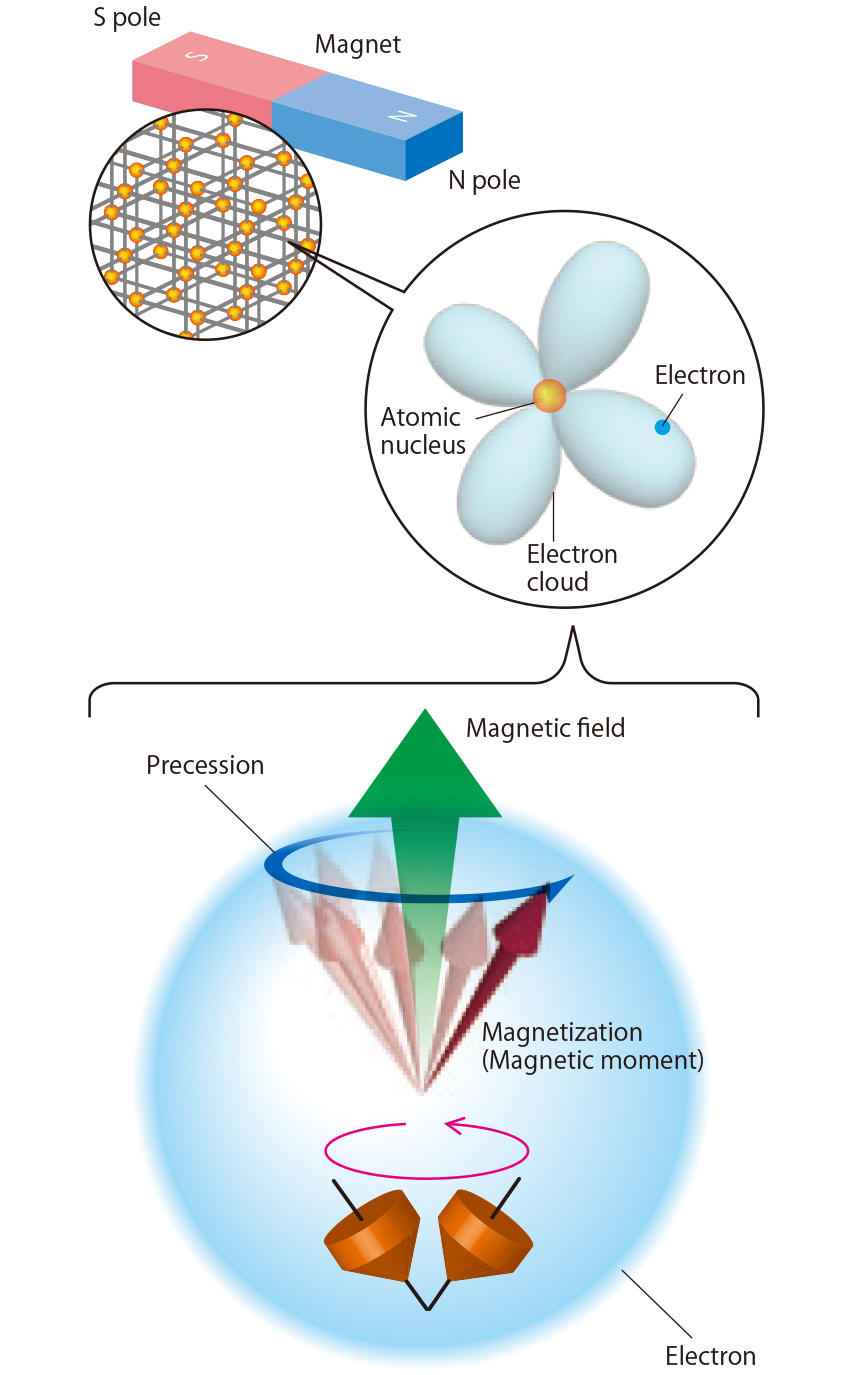
Fig. 1 Electronic spin is a magnet in the microscopic world
As electrons around the atomic nucleus spin, magnetization (magnetic moment) occurs and functions as a permanent magnet. There are two kinds of electronic spin in terms of direction – up spin and down spin – and this direction determines N or S pole.
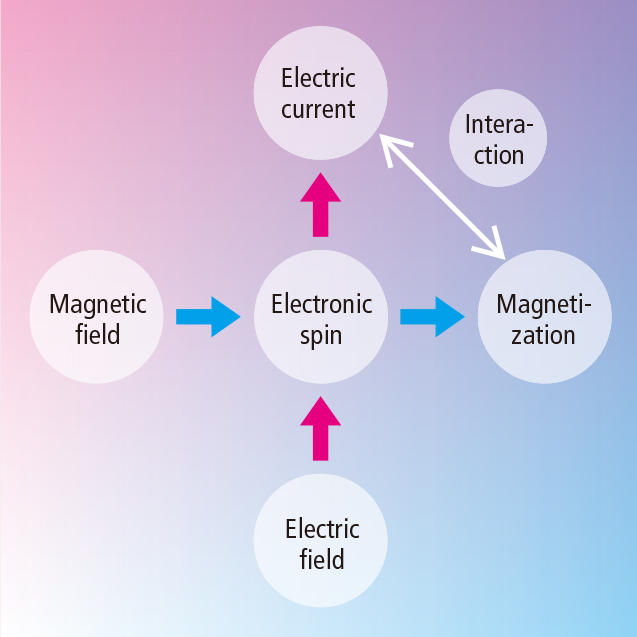
Fig. 2 Concept of spin electronics
Within a given substance, electric current induced by the electric field interacts with magnetization induced by the magnetic field. Using this interaction, it is possible to control magnetization by electric current and vice versa.
Elucidation of 4 types of torque is the key to effective control of electronic spin
Key to effective control of electronic spin is the force (torque) that works on electronic spin. This torque comes in four types: (1) damping torque; (2) precession torque; (3) spin transfer torque; and (4) non-adiabatic torque (Fig. 3). When magnetic field and/or electric current are given as stimuli to electronic spin, these four torques work to reverse electronic spin. This is already theoretically confirmed. Especially when it comes to the relationship between torque’s action and magnetization reversal when magnetic field is given as a stimulus, there are prior research works as seen in the example of HDDs mentioned above. “By contrast, research into magnetization reversal via electric current has just begun, with few research endeavors being made. Unlike magnetic field-based magnetization reversal, magnetization reversal via electric current is highly efficient as it can directly access individual ferromagnetic devices, thus realizing high-speed motion of tens of GHz with limited power consumption,” remarks Dr. Nozaki explaining advantages of electric current-based control.
What Dr. Nozaki pursues is research into how to quantify each torque that results when electric current has been used as a stimulus. And his aim is not only to reverse the spin but also to reverse it most efficiently – at even higher speeds and with less stimuli.
So he attempted to shed light on how effectively each of the four torques, when electric current is given as a stimulus, would work on magnetization reversal. However, the subjects are too small to observe changes in individual electronic spins and to analyze actions by each of the four torques. This led Dr. Nozaki to notice a magnetic structure comprised of multiple electronic spins and make the most of its characteristics.
“Between adjoining electronic spins there is interaction to maintain their directions parallel to each other. If you reduce the size of magnetic devices to the nanometric scale, therefore, it becomes possible to analyze the behavior of an individual electronic spin by judging from the collective behavior of the electronic spins as a whole. For example, by reducing the size of a given material to something like 100 nanometers, it is possible to realize electronic spin in which all the individual electronic spins move in unison with each other. Furthermore, by arranging individual electronic spins in the shape of a disk, the electronic spins seek to harmonize with each other and form a magnetic vortex as a result,” remarks Dr. Nozaki. These magnetic structures are extremely high in stability and show simple and linear reactions to stimuli given, making it easy to analyze the four torques. However, when the size of the collective electronic spin exceeds 10 micrometers, the spin tends to take a stable structure at several different locations, making the overall structure complex.
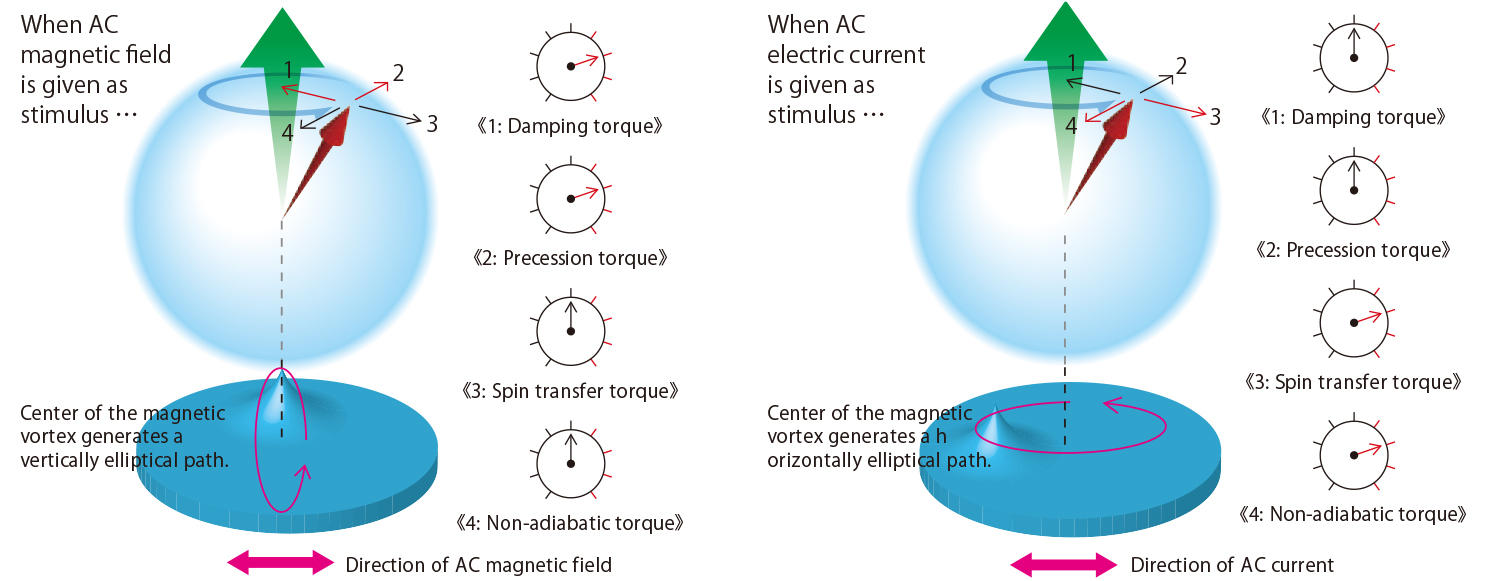
Fig. 3 4 torques that act on electronic spin
Four torques act on electronic spin. These are regarded as factors that determine the direction and motion of the magnetic moment. Since all of these torques directly interact with the magnetic moment, they can alter the direction of the magnetic moment without changing the moment’ s magnitude. If frequencies of the magnetic field and electric current given as stimuli are changed, the torques change their respective actions, which will appear as changes in the turning path of the magnetic vortex. This means that by analysis of changes in the stimuli given and changes in the magnetic vortex it is possible to quantify changes in each torque relative to stimuli given.
Potential applications ranging from magnetic memory to logic devices
“Research into macrospin and magnetic vortex is making rapid progress, shedding light on the behavior of electronic spin,” Dr. Nozaki says with a smile. “For example, if you use AC current as a stimulus to a magnetic vortex, the center of the magnetic vortex resonates with the stimulus and begins to rotate in a concentric manner. It has been well known that at this time, the linewidth of resonance spectrum has much to do with (1) damping torque, and the resonance frequency with (2) precession torque, respectively. However, a discovery was made of late that a significant change in the frequency of electric current given as a stimulus transforms the vortex’s path from a concentric shape to an elliptic one. After further detailed calculations, it has also been found that from the shape of the elliptic path it is possible to obtain (3) spin transfer torque and (4) nonadiabatic torque (Fig. 3). I’m now moving forward with verification tests for this theory,” he continued.
Elucidation of relationships between the four torques and stimuli will pave the way not only for quantitative determination of magnetization reversal via electric current, but also for development of new applications, such as high-speed magnetic memories and rewritable spin logic devices (Fig. 4).
“As electronic spin control increases in speed, it will come to be used as a micro switch that switches electric current ON and OFF. It will also make a postsemiconductor device technology a reality, which will enable an all-purpose electronic circuit capable of rewriting data into diverse functions, for example.”
Indeed, electronic spin is a focus of attention today as a technology that will lead to the development of epoch-making devices.
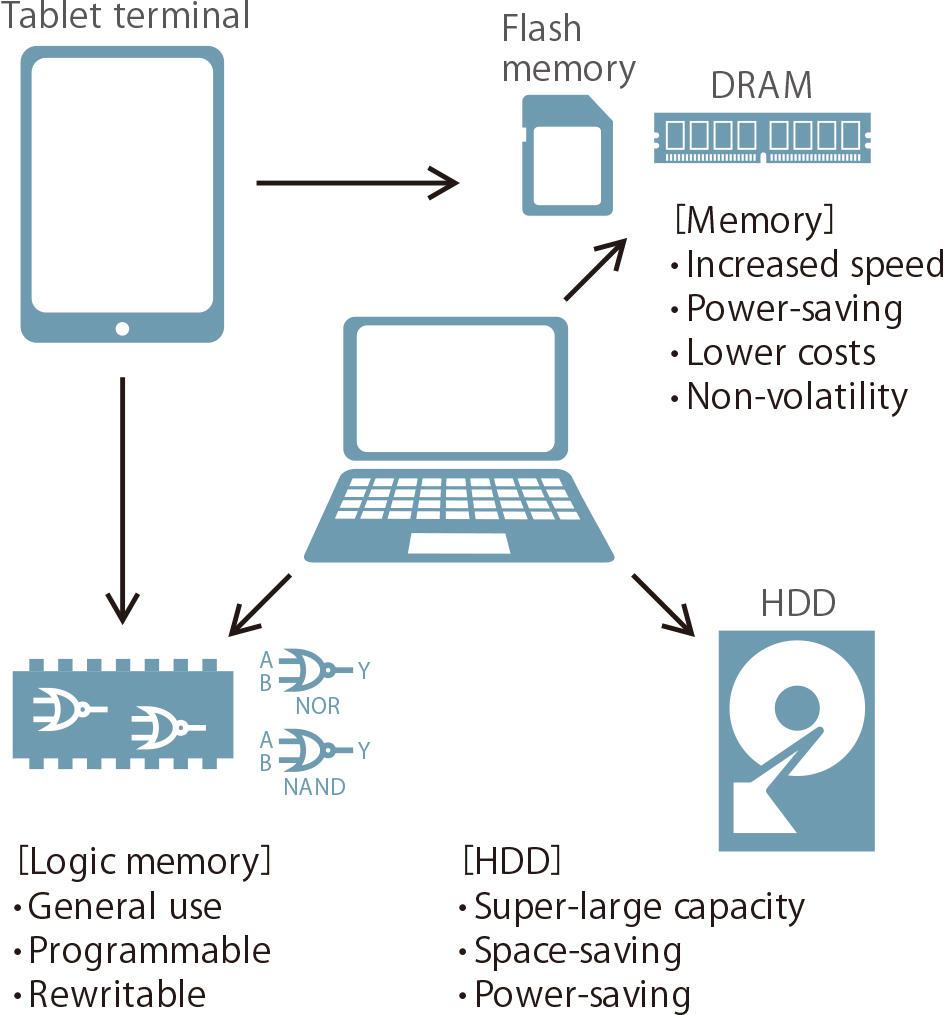
Fig. 4 Application electronic spin to devices
Expectations are high for electric spin for applications to magnetic memories that enable zero consumption of standby electricity, and electronic devices capable of rewriting into various functions.
Interview
Listening to what Associate Professor Yukio Nozaki has to say
As a child I disassembled a camera – for curiosity about its mechanism
As a small child was there anything special you were crazy about?
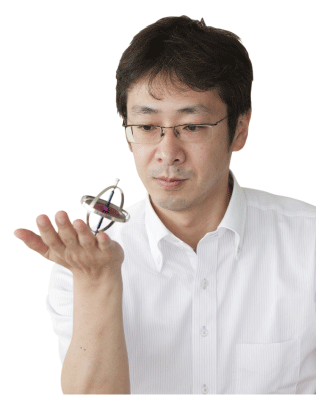
According to my mother, I was a child who liked disassembling mechanical things. Since my parents were self-employed, they were usually away from home most of the day. And also because I was an only child, I used to play alone. One day, mother returned home and found me disassembling a camera. If I remember correctly, I wanted to know about the camera’s mechanism rather than simply disassembling the camera for fun. Yes, I remember I was curious about what kind of mechanism makes it possible to take photos, and why the camera makes a click when the shutter is pushed. These questions were wonders and caught my interest. Presumably, the camera’s back cover might have come off as I repeatedly opened and closed it in an attempt to look inside – the beginning of disassembly. By the time mother came back home, the camera might have been reduced to screws, parts and so on. I was bitterly scolded. Mother often told me that I had done similar things again and again even after that event. For example, as a gift for my congratulatory occasion my grandmother bought a swing for me to play on in the garden. But before enjoying it, I disassembled the swing set into pieces. Curiosity about its mechanism might have been irresistible. Because of all these events, it seems to me that mother found me definitely suitable for science and technology. Then she switched her policy: instead of things being disassembled, she gave me plastic model toys, which allowed me not only to disassemble but also reassemble them. From this time on, I also became interested in making things.
Did you like scientific subjects at school as well?
I wonder. Rather than love of scientific subjects, what occurred to me above all else was awareness of my weakness or dislike of liberal arts-oriented subjects. I liked mathematics and science because I could think and work out answers on the spot. But I was poor in subjects that require day-after-day constant learning (particularly by rote). My performance in writing kanji characters to dictation was truly miserable! Although I could somehow manage these subjects by last minute cramming for examinations up to the end of junior high school, such a makeshift technique didn’t work at all in senior high school. Naturally I stayed away from liberal arts subjects and set my mind toward scientific subjects like mathematics and chemistry. But physics was an exception. All that was required was to work out solutions to hypothetical problems. Back in those days, physics was a subject totally lacking a sense of reality (as it seemed to me). I could little appreciate the true, intrinsic fun of physics.
When it comes to mechanics, for example, a question like this may be presented: suppose a ball is placed on a slope and is rolled down the slope, how far can the ball climb an upslope in front of the bottom of the slope? As a high school student, I couldn’t appreciate the use of such a question. Putting an imaginary ball on an imaginary slope, rolling it down the slope and estimating the ball’s movement . . . Things like this seemed to me nothing but an empty proposition, which didn’t interest me at all. Speaking of electrodynamics, an intriguing phenomenon was posed as a question – a phenomenon that exerts a force between two substances at separated positions. In this case, no explanation was made of the underlying principles of magnetic field and electric field that cause the phenomenon.
By contrast, in chemistry, you can reenact a reaction before your eyes if you combine chemicals just as described in the chemical formula in question. It seemed to me chemistry is more realistic or interesting.
Knowing the fun of physics in classwork by my respected teacher
You mean chemistry is more interesting as it can explain the realistic world?
Well, compared with physics that seems somewhat disconnected from reality, chemistry appeared to be simple and straightforward, allowing the cause and effect to be directly connected. This is why I was attracted more to chemistry in high school. Chemistry even appeared to me as approaching straight into the essence of things.
To tell the truth, I became aware of the fun of physics only after I was admitted to Keio University. The impetus was a friend I became acquainted with on campus. I was influenced by him stressing that physics is excitingly interesting and pursuits other than physics are not worthy of learning. At that time I thought I would keep physics as one of my options. What determined my course of life was a class on electrodynamics by Dr. Hideki Miyajima (now Prof. Emeritus). Dr. Miyajima’s teaching was free of unreality – it was truly convincing, easy to understand and interesting, which made me think that physics might be fun to study. It was when I was a sophomore. Frankly speaking, I wish I became aware of this a little earlier.
One of the things I took to heart after I began teaching at the university was the difficulty of teaching physics while conveying the sense of reality to students. In order to explain the essence of various phenomena, it is unavoidable to describe the microscopic world from a physics viewpoint. In the microscopic world, electrons and the like that constitute a substance behave in a manner entirely different from the sense of our daily lives, which in turn is very intriguing. However, we need to use complex formulas to explain it – too difficult for high school-level physics. To really appreciate the delight of physics, you need to clear a high hurdle. In other words, physics offers delight proportionate to the height of the hurdle. I must also confess that I came to find and appreciate some attractions of physics only after I became a teacher myself. Keio University’s motto “Half Learning, Half Teaching” is coming home to me.
I’m also trying to convey the fun of physics to students through classwork, but it’s quite a challenge. I’m now trying various ways to make my lessons memorable. One way is encouraging my students to hand-write on a blackboard instead of using PowerPoint, for which the students are required to move their hands. This can provide an episode that interfaces physics they are learning with actual reality. This episode may serve as an impetus for arousing their memory later on when they need to restudy what they learned before. Even vague memories, such as writing a series of complex formulas on the blackboard were tough, and using unfamiliar formulas was a challenge, are much better than total loss of memories.
About when did you make up your mind to choose a researcher career?
I became serious about becoming a researcher after I belonged to Dr. Miyajima’s lab and began to study in the master’s course. When I was looking for a research theme, a research associate of our lab, who was about to visit France for research purposes during the summer holidays, happened to be looking for a student who would accompany to assist him. I raised my hand the moment I heard of this offer. Since nobody else volunteered to do so, my visit to France was decided.
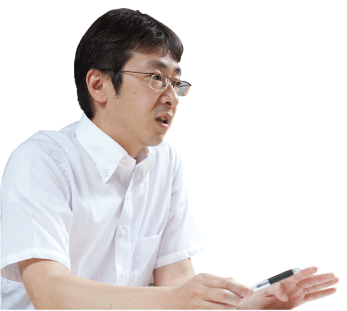
To tell the truth, I raised my hand simply because I wanted to visit and see France. In retrospect, however, my visit to France turned out to be a major turning point in my life. The experience I obtained there was so valuable that it made me strongly conscious of my future career as a researcher. All of the students and researchers whom I met in France were highly motivated naturally as they had also come all the way to France for their research purposes. Furthermore, our stay was limited to two months, which made us all the more devoted to research work whether willing or not. Through the two-month period of devoted research work in a foreign country like France and surrounded by highly motivated foreign researchers, I became aware of the delight of concentrated research. I found research activity exciting enough even for an assistant like myself. Then how wonderful would it be if the research work were for my own sake? This was my impression, which urged me to choose a researcher career. Looking back at my life, I think I am a lucky person blessed with encounters with good people – a campus friend who was a physics enthusiast; Prof. Miyajima who gave me intriguing classes and whose lab I could belong to; and the many foreign researchers I met in France and worked together with day after day . . . Indeed, I have been assisted by a number of highly competent and friendly people at each turning point in my life. I owe what I am today to these people and am truly thankful.
Concentrate on what you’re doing, especially when you are at a loss
Is distinction between research and your private life difficult?
Before marriage, research work was everything in my life. But after I got married, I changed my lifestyle and became able to distinguish my private life from research work, especially with the birth of my first child. Because preparing for lectures for the following day is demanding and time-consuming, I sometimes have to do it at home. But I completely enjoy private time when communicating with my children. In fact, dealing with children is a great task itself and my hands are full. Frankly speaking, physics is the last thing I can think of. I have little idea of what my children are thinking of, and their thinking is not logical at all. But their pointlessness and unmanageable behavior are fun, maybe. For sure, children are a matter of greatest interest for me.
What do you want your students to learn?
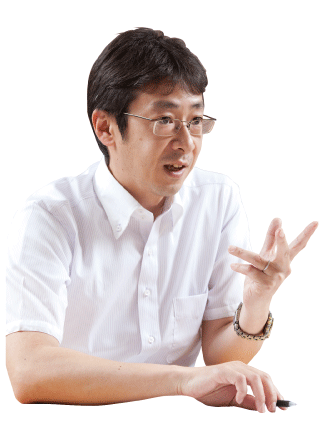
As advice based on my own experience, I’d like my students to identify a research theme they find intriguing. The field doesn’t matter. If there are some who have already identified their themes, they should proceed that way. For others who have not found their themes yet, I’d like them to focus on something at hand even for the time being, by suppressing their mind that is indecisively wandering this or that way. Some may say it’s not cool to focus on one particular thing. But remember that you are in an enviable environment where you can study. Then why not take advantage of it? When you focus on something, soon you may run into one obstacle after another. But by overcoming such obstacles one by one, there may be a moment when your horizon expands dramatically. It must be this moment that you can appreciate the true width and depth of the world. As students, you may have to deal with many things aside from academic learning. But please remember to concentrate on something especially when you are at a loss of what to do or which way to go. I’m sure that by doing so you will have a moment when things formerly in question get interrelated with each other and emerge as something convincing before your eyes. I’d like all my students to capture such a moment.
Just a word from . . .
Student A : While in the general education course, my impression of Mr. Nozaki was one of a strict teacher. But this impression changed completely when I joined his lab. When I asked a question during research work, not only did he give me the correct solution, but he also explained step by step how to climb the stairs of understanding while encouraging us to think on our own. His approach often convinced me, the questioner, as well as other members of the seminar. Thanks to Mr. Nozaki’s educational approach, it became possible for me to address and understand difficult challenges.
Student B : With Mr. Nozaki, distinction between research work and other things is very clear. While in the lab, he talks only about the research work in question. But outside the lab, for example in the cafeteria, his topics range widely even to the outcome of World Cup Soccer. This makes him even more attractive. This year falls on the third year of the Nozaki lab. So we are planning to have a boarding session (for study and friendly communication). I’m looking forward to it as we may find new aspects of Mr. Nozaki’s personality.
(Reporter & and text writer: Kaoru Watanabe)


